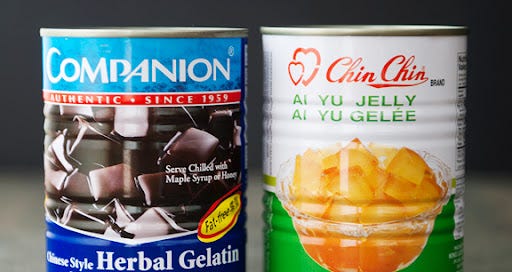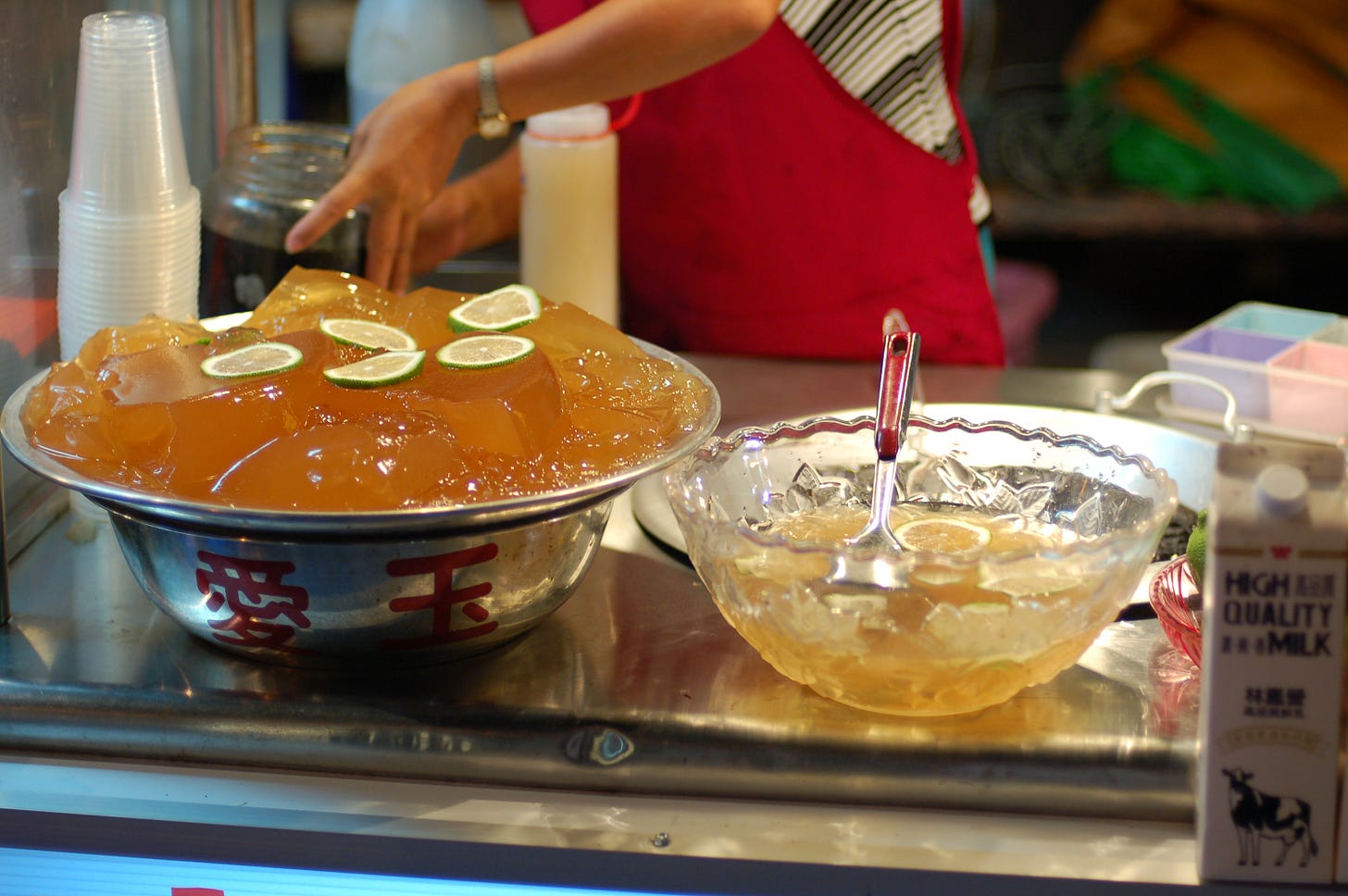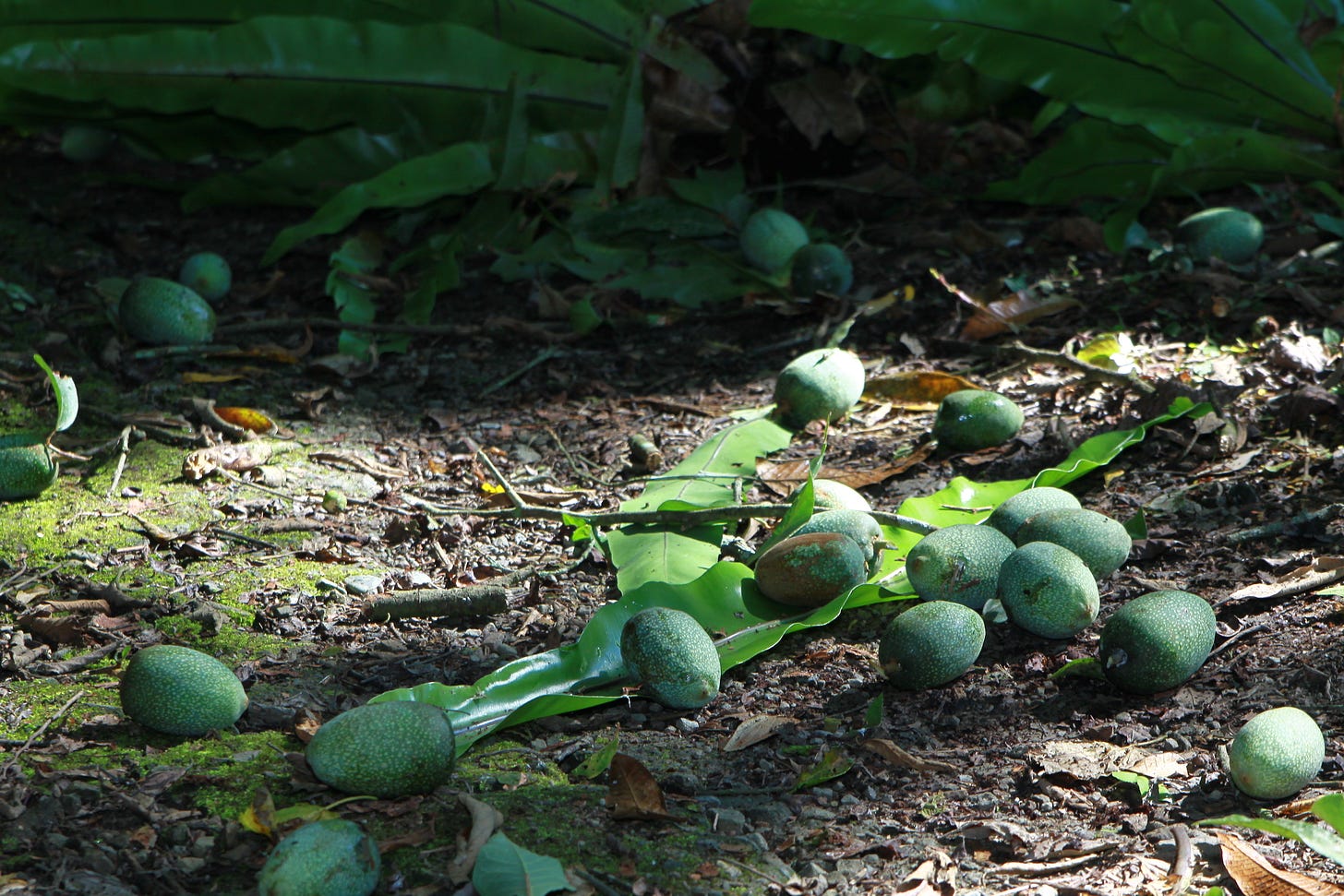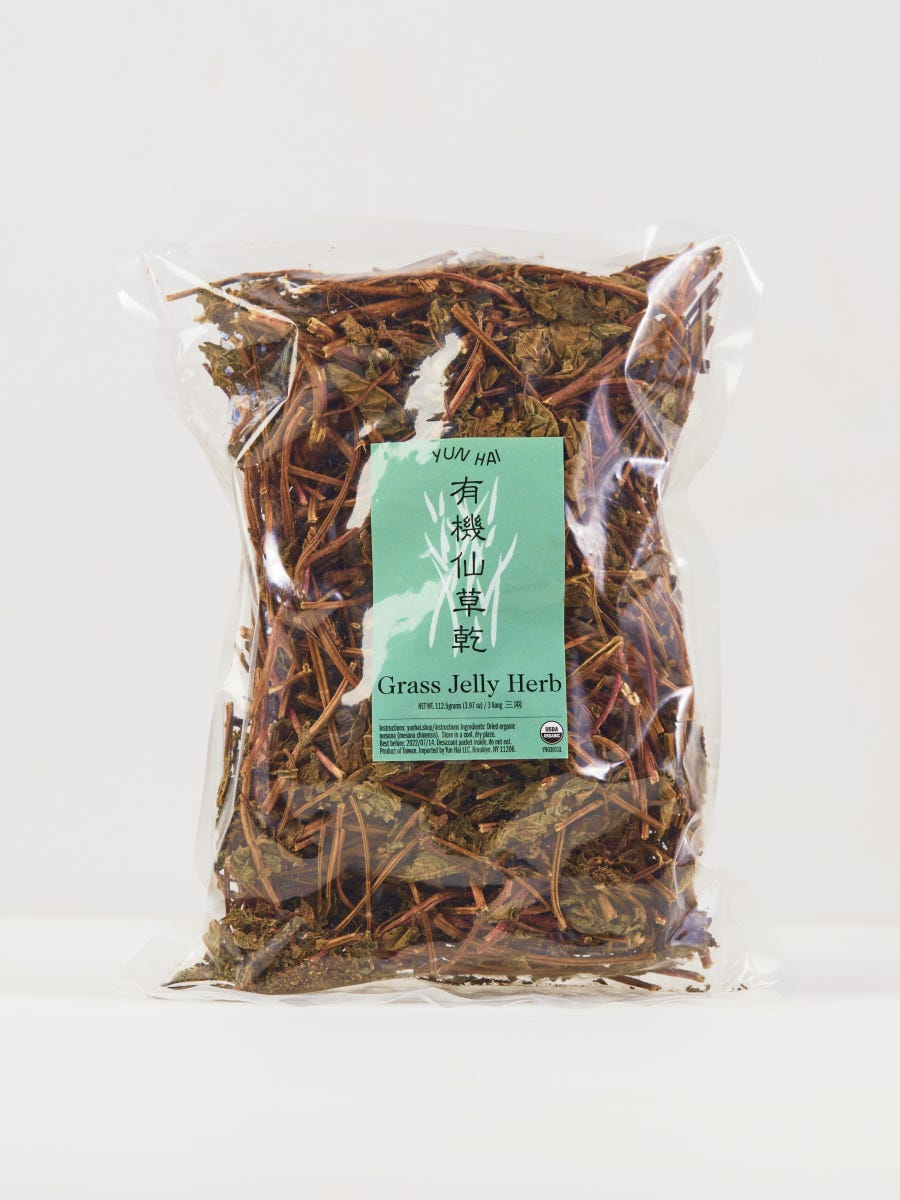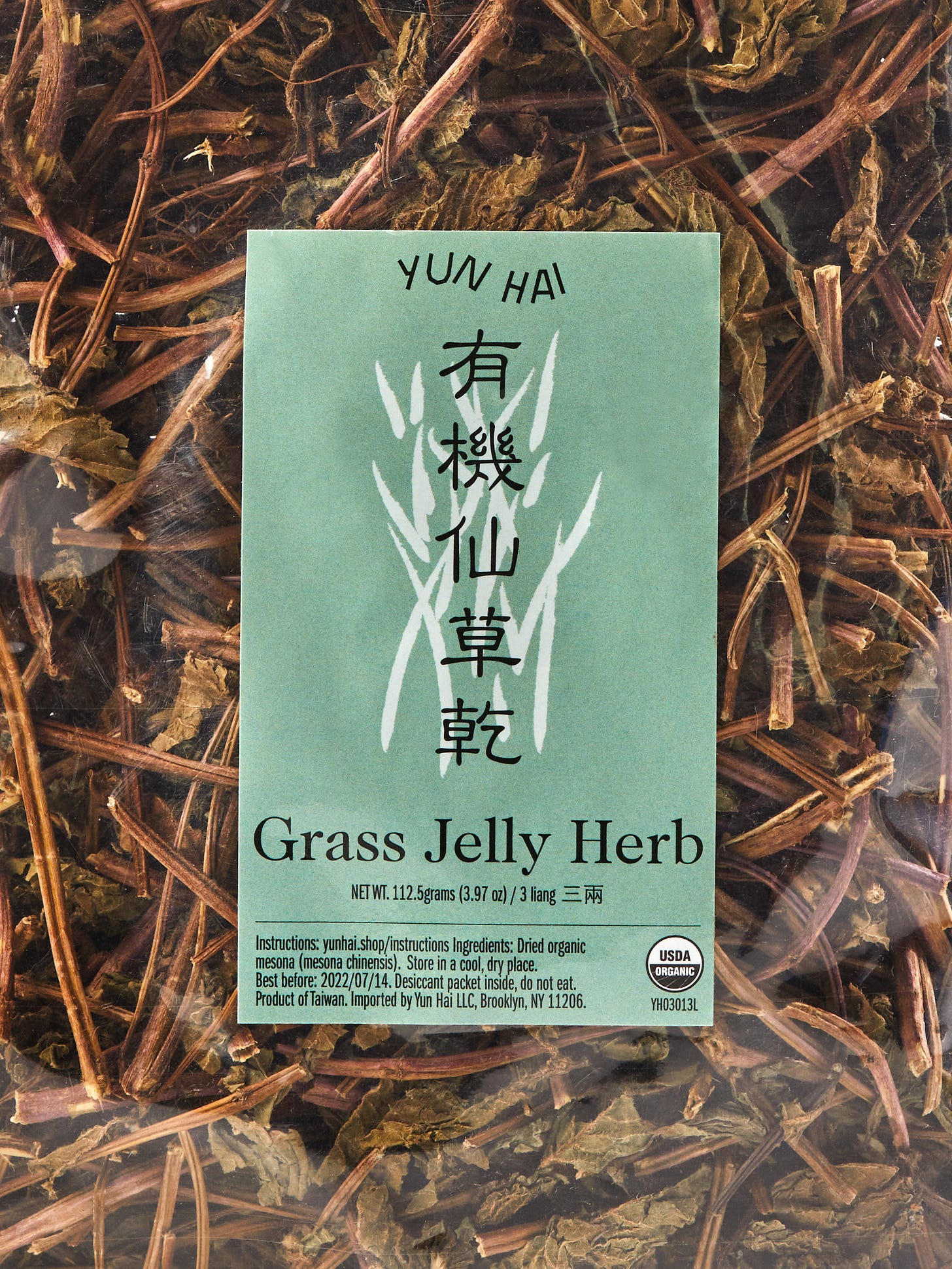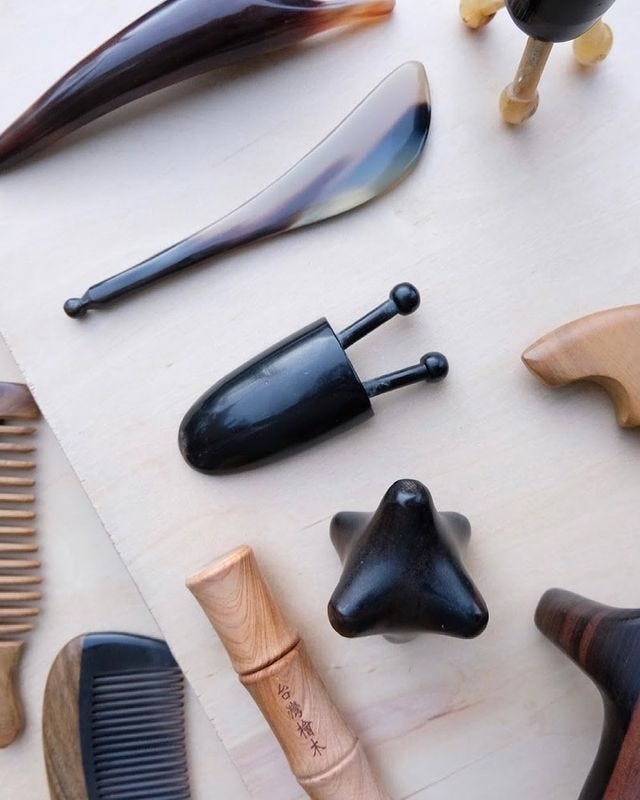愛玉,仙草: Ai Yu Fig, Grass Jelly Herb, and the Continuum of Texture
Plus, Taiwanese units of measure, our favorite home goods store, and a call for all your burning questions about Taiwanese food
This is Yun Hai Taiwan Stories, a newsletter about Taiwanese food culture by Lisa Cheng Smith, founder of Yun Hai Taiwanese Pantry. If you found your way here but aren’t yet a subscriber, sign up here.
Another month, another product! Today, we’re launching Ai Yu Fig Seeds and Organic Dried Grass Jelly (Mesona) Herb, raw ingredients for my favorite Taiwanese drinks and desserts. To celebrate, I explore the fascinating texture of herbal jellies and teas; take a look at customary Taiwanese units of measurement, often used in traditional markets; share our favorite shop for Taiwanese home goods; and ask for your questions on Taiwanese cooking, to be answered in a forthcoming column.
Q滑 Jelly Belly
All my favorite desserts in Taiwan have a strong jelly component. “Q”, the darling of Taiwan’s texture exports, describes the bouncy chewy texture of boba or a perfect fish ball. But I’m talking about Q滑 (translates to Q Slide?), the slippery, soft, cool, suspension found in Grass-Jelly-with-my-Bubble-Tea, Frogs Lay Eggs 青蛙下蛋, Ai Yu Jelly 愛玉冰, and Almond Tofu 杏仁豆腐.
As a child, we always had the cans of Ai Yu and Grass Jelly in our pantry, stacked and shrink-wrapped in their cardboard trays. I remember the delight of sliding the cylindrical, ridged jelly blocks out of the can and slicing them up—zero resistance through the black, jade-like brick and the yellow prehistoric amber goo. I can still recall the pure anticipation I felt while mom mixed it with fruit, lemon juice, honey syrup, and crushed ice from our fridge.

Years later, I experienced fresh Ai Yu Jelly, Grass Jelly and many other goos and gloops right off the plane on my first trip to Taiwan (you know, roll up to the Howard Hotel at 1am, leave bags at desk, order a taxi to Shihlin 士林 without a bathroom break). I’ve never looked back and have been a jellyhead ever since.
I’m not alone in my love of these ingredients. Many of you have reached out to request that we carry them. Zoey Xinyi Gong, Traditional Chinese Medicine Nutritionist, told me her childhood jelly memory: “Growing up, I always asked my grandparents to make me grass jelly or Ai Yu as dessert. We lived in Shanghai, a very hot and humid city in the summer. Ai Yu and Grass Jelly are not only light in taste but also cooling in nature to help reduce heat and water retention in the body. My favorite combo was to have them with homemade ube mochi and osmanthus flower syrup!”
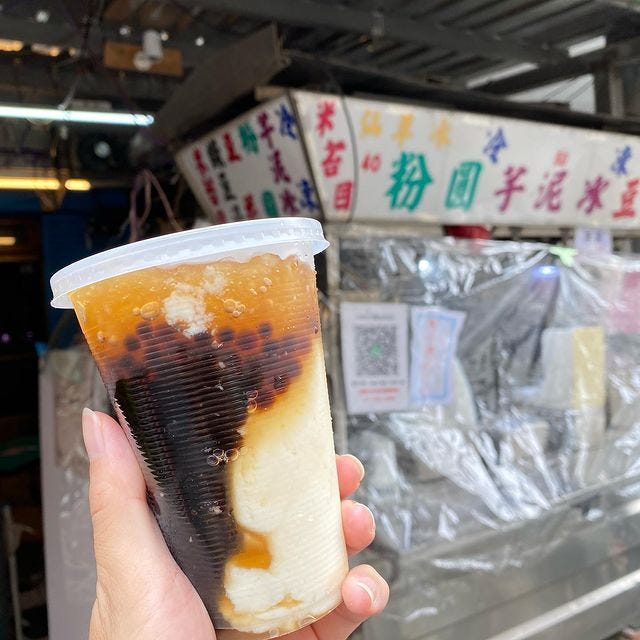
When made fresh, these jellies, gels, liquids and pearls create a universe of texture, ever changing in time and combination. The continuum between liquid and solid has as many states as there are decimals between 0 and 1. It’s the ultimate grey area, a universe where we’ll never run out of places to go. This includes the pure liquids too, the 0 states. At Yun Hai, we’ve been discussing how strange it is that Grass Jelly Tea has the word Jelly in it, when it’s really Mesona Tea, decidedly not a jelly, but a little bit of body and a whole lot of murk.
It’s hard to get this stuff fresh in the States. The ingredients to make these teas and jellies are commonly available in powdered or premixed forms, for ease of preparation, storage, and transportation. Some super niche tea and dessert shops might be boiling vats of Grass Jelly, but most are not. It’s difficult to find good boba, let alone the fermented, aged, and dried Mesona plant (that makes grass jelly) or the Ai Yu Fig seeds (that transform water into a perfect suspension of quivering fig pectin). These ingredients have deep natural histories, and when cooked up fresh, from scratch, that history can be tasted.
I am so excited to announce that Yun Hai is now offering Ai Yu Fig seeds and Dried Mesona (Certified Organic) so we can all experience these textures and flavors in their glory and variety. It’s more work to prepare desserts this way, but if you’re curious, please browse the how-to and give it a try. Your mind, body and spirit will thank you.
愛玉 Ai Yu Fig
In the high heat of Taiwan summer, cool off with Ai Yu Jelly 愛玉冰 , an amber-colored jelly served with lemons, honey and wild starch pearls 山粉圓 in teashops and night markets. It’s healthy, too—mostly suspended water and soluble and insoluble fiber. It’s not sweet on its own, but with raw honey and citrus, this is the golden child of summer desserts.
The jelly is made from the seeds of the Ai Yu Jelly Fig (Ficus pumila var. awkeotsang), a plant native to Taiwan with deep significance to the indigenous communities in the Alishan Mountain Range. The seeds are collected in a cloth bag and rinsed in spring water. This causes them to release their pectin, which interacts with the minerals in the water to set into a jelly. Within a few hours, the Ai Yu is ready to be scooped out, gently, quiveringly; a true texture of Taiwan.
The natural history of Ai Yu is untamed and beautiful. Ficus vines creep up old growth trees in the Alishan Mountain Range, fruiting two stories high and thriving for decades. An Ai Yu fig wasp, evolved specifically to this plant, pollinates the flowers, allowing the vine to develop fruit. The ripe figs fall to the ground and seeds spill into spring fed creeks, releasing their pectin and, as the story goes, creating spring-borne Jell-O. This stuff is truly wild, and is as much a gift of the wasp as of the plant. Though the vines are grown ornamentally worldwide, they fruit only in Taiwan, because it’s the only habitat for this wasp.
Our Ai Yu seeds are sourced from a family-owned operation that have grown figs in the Alishan Mountain Range for over 30 years. The cultivar they grow is the original Alishan wild jelly fig, with a very high pectin yield (1:78 seed to water weight ratio, for the Ai Yu Heads out there). The fruits are harvested and dried by hand.
仙草 Mesona, Grass Jelly Herb
Grass Jelly 仙草凍 is an herbal dessert consumed throughout Taiwan at all times of year. In the summer, find it cubed with taro and sweet potato balls and condensed milk. In the winter, have it warm with chewy tang yuan. Grass Jelly or Mesona Tea 仙草茶, a cooling beverage, is served hot or cold in tea shops and from traditional tea 古早茶 trolleys year round. The flavor is something between mint and rooibos, but so much more.
Grass Jelly is made from Mesona Chinesis 仙草, a member of the mint family (yep, square stems). In addition to being a favorite dessert ingredient, it’s been used for medicinal purposes in Taiwan for centuries, primarily to cool the body and aid in digestive health. To prepare mesona, the tea is brewed by boiling the stems and leaves of the plant. This is either consumed as a drink or further set with starch (traditionally tapioca) and sweetener into a jelly.
Our certified organic Grass Jelly Herb (Mesona) is grown in Miaoli County, Taiwan using no fertilizers, pesticides or herbicides. Growing high quality Mesona requires the right balance of moisture and sun. Miaoli County is perfectly suited, as the mountains fill with clouds in the afternoon, creating a humid and cool microclimate for the Mesona. The grass is aged in much the same way as Oolong tea, fermented for over a year to create deepen the colors and the flavor.
分兩斤 Taiwanese Units of Measure
Taiwanese packaged goods and wet markets have their own traditional units of measure, still used along side metric units. These are derived from ancient Chinese units of mass, but have evolved and are all their own. Though similar units are used throughout Asia, they all mean something a bit different.
We included these traditional units of Taiwanese measure in our packaging, partially because the standards are familiar to us (you can still purchase things by the liangs and the jins) but also to honor the unique history of Taiwan.
Taiwanese American Business We Love: The Wax Apple
The Wax Apple is a retailer of Taiwanese craft goods for home, kitchen, and self. It’s run by Juliana Hung, who was inspired by her Grandmother’s daily life. I can personally vouch for the house slippers, wooden massagers, and linen clothing (with cloth buttons). She’s an amazing chef too. Not to be missed.
Grandmother had a driver who had taken her around for thirty years, and he was my ride too if I wanted to go out to the countryside. She would always want to come, though. Grandmother was never a homebody. I don’t think she’d spent a whole day inside her entire life. We’d go out to look around and she’d be on her phone calling people, like cousins and father’s accountant’s wife. How could they say no about joining us for lunch? She had been a teacher in the small town where she met my grandfather, and together they had traveled everywhere. One trip, she brought back gold rings with elephant hair embedded in them. She gave me one, and I found another rummaging through her things, and wear them both every day. If you went over to her house, grandmother would ask, “Did you eat yet?” and suddenly there would be pineapple cake or maybe a sliced wax apple, stuck with tiny forks.
The Wax Apple is all the things that are like a day with my Grandmother in Taiwan.
A Call for Food Qs
One of the goals of starting this newsletter was to serve as a resource for those who were interested in Taiwanese food and culture. I’m running an open call for your questions about Taiwanese food and ingredients, and I’ll respond, column style, with the best research the Yun Hai Team (now four strong) can pull together on the topic. Please post your questions in the comments or simply reply to this email. I’ll choose at least one to answer next time around.
Back to bathing in Mesona,
Lisa Cheng Smith
If you enjoyed this newsletter, please share it with friends and subscribe if you haven’t already. We email once a month, sometimes more. For more Taiwanese food, head to yunhai.shop, follow us on instagram and twitter, or view the newsletter archives. If you’d like to see a topic covered or have a burning question that needs an answer, please leave us a comment.

